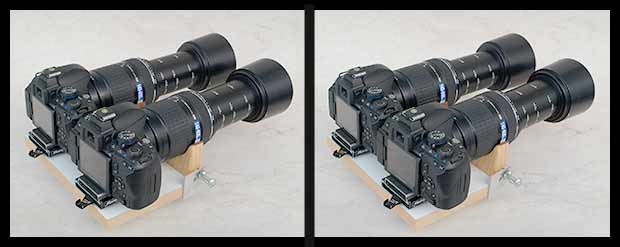

Cross-eye stereo photograph of telephoto rig by Alec Kennedy
Alec uses two digital, Olympus, E 620, SLR cameras on a home-made mount. A narrow mount is illustrated here, but he uses up to 1 meter stereo base when required. |
Photography from a hide: Alec Kennedy
The bait for the wild harriers was dead possum. Australian possums are a pest in New Zealand, doing severe damage to native trees and farmers are encouraged to eradicate them. Traps and poison are used, but I prefer shooting them at night, using a powerful air-rifle fitted with a spot-light and telescopic sights. This provides food for the dog and bait for the hawks. It only took a few weeks to get the hawks accustomed to feeding on possum on the lawn outside the kitchen window, even as close as a few meters. My first photos had too much background disparity so I moved the bait closer to the nasturtium bank. Shooting through one (open) window I could use a separation of 300mm but the stereo image was "cardboardy." I have 3 adjacent windows but only the two outer ones open, so I had to increase the separation to 1 meter to shoot through them. This gave a bit of hyperstereo, and excess background disparity even with the harrier close to the nasturtiums. To reduce the stereo base to 600mm I then set up a hide outside the kitchen window giving a subject distance of 14 meters to the nasturtium bank. I also found that moving around inside the hide did not disturb the harrier. Double bonus. The hide is a plastic cover draped over a stock crate on the back of a trailer. There is quite a lot of room inside for me and the cameras. I have only triggered the cameras from within the hide, not remotely from the kitchen. Since I'm using spot focus for each shot I need to continually adjust the camera aim. Over summer the hawks have been too well fed and there haven't been good photo opportunities. Also the bait site has been in the shade of a plum tree. It's now autumn so the tree has dropped its leaves, giving better lighting again. Also the hawks are hungrier. Time to try for some more 600mm photos. The original results are in full colour and you can see some of them on the "3dpan" Flickr site, in cross-eye format.
Images:
Use red/cyan anaglyph goggles to see in 3D. |
Computing telephoto stereo base: John WattieRoundnessFirst decide how the images are to be seen and what the viewing distance will be. This determines the stereoscopic roundness. For computer viewing at 1 meter, a base of n/15 is good. n/30 = 14000/30 = 466mm n/15 = 933mm or nearly 1 meter Maximum Acceptable Deviation (MAD)This is set from the distance between the nearest object (n) and the most distant object (m). It can be computed accurately from the Bercovitz formula, or near enough from the pin-hole formula.
For use here, the formula is better re-arranged to find the maximum distance, m, since we already know the nearest distance, n, is 14 meters from the hide. n = nearest distance: 14 meters m = 1 / ( 1 / n - P / B F ) m = 1 / (1 / 14000 - 1.2 / 466 x 600) = 14894mm = 14.9 meters 14.9 - 14 = 900mm is a very small working distance and the background here is 1000 mm beyond the closest object. So the 600mm stereo base and/or the 600mm focal length must be too big. The harrier needs 600mm telephoto to fill the frame, so the stereo base has to be reduced. The choice is to make a lot of experiments, wasting time and energy, or to calculate the base once. B = P / ( F (1/n - 1/m) ) B = 1.2 / ( 600 (1 / 14000 - 1 / 15000 ) ) B = 420 mm
ConclusionA 400 to 420mm base should be excellent for projection on an amateur size screen ( 4 foot, 1.22m ) and gives a roundness when viewed from 2 meters of: Roundness = R = 420 / 466 = 0.90 (Pin-Hole formula) SO, my advice to Alec is to use a 400 mm stereo base, from 14 meters away and then the stereo pair, through his 300mm lens on 4/3 camera, should be suitable for projection. Maximum fractional deviation should then be around 1/30, which is the recognised value for amateur projected images, according to the ISU For computer viewing, Alec's original 600 mm (big screen) to 1000mm base (smaller, portable computers) seems fine to me. |
Circus approximans
Kahu
Often called a hawk, but experts, when not talking Latin, tend to confine that name to the New Zealand Falcon.
A friend from USA, while admiring the stereo image, wanted to call it an eagle, but that is certainly wrong!
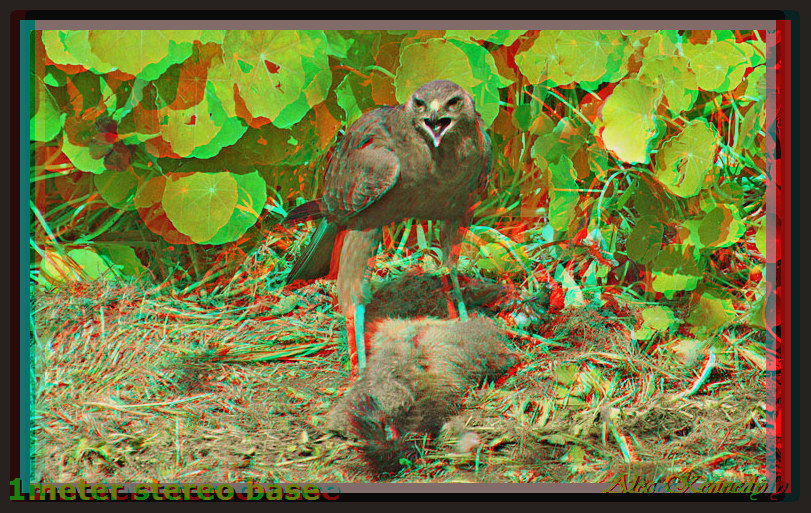
Stereo base = 1 meter
n = 16 meters
m = 17 meters
Roundness when viewed at 1 meter = 1000/ 1067 = 0.94
Roundness when viewed at 2 meters = 1000/ 533 = 1.8
Maximum disparity has been reduced by using a floating window.
Since this copy of the image is not at full screen size, maximum disparity on a computer is only 11mm.
That should be easy to fuse for most people, and roundness is fine on a computer.
However, the image is not suitable for projection.
11/210mm is 1/19. The ISU projection limit for maximum deviation is 1/30.
This harrier exceeds ISU (and NSA) limits by a large margin.
Also, the roundness is stretched.
The Sky TV limit for 3DTV is 2% (1/50) for uncrossed disparity and
1% (1/100) for crossed disparity. Total disparity 3% (1/33).
Floating windows, as used here, are ideal for spreading the disparity in front and behind the screen surface
and are advocated by Sky TV.
(The warm anaglyph colour comes from the Dubois algorithm)
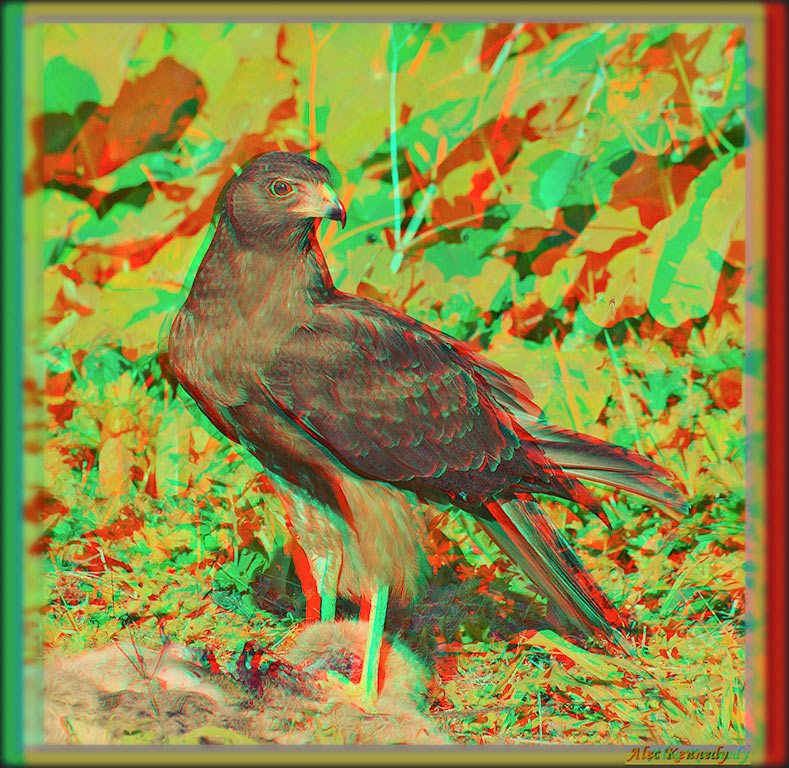
Stereo base = 500mm
Roundness viewed at 1 meter = 500 / 933 = 0.5
Roundness viewed at 2 meters = 500 / 466 = 1.07
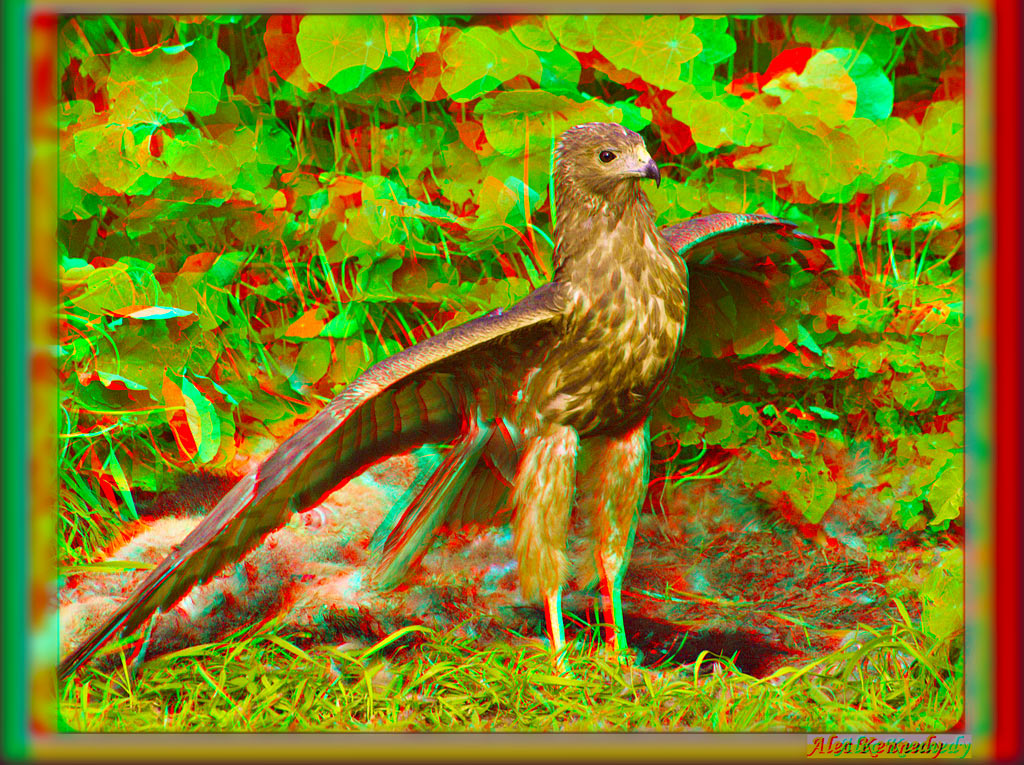
Stereo base = 500mm
Roundness viewed at 1 meter = 500 / 933 = 0.5
Roundness viewed at 2 meters = 500 / 466 = 1.07
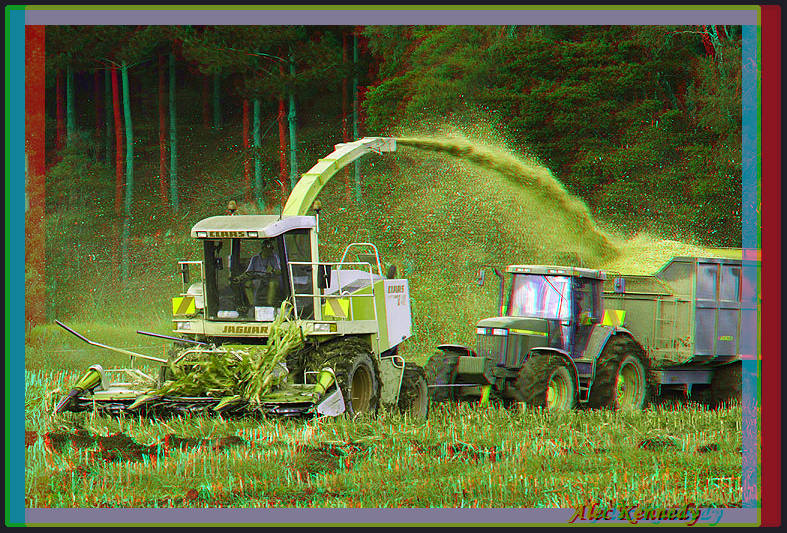
The Harvester
Radio control of the two DSLR Olympus cameras is so good that the harvested particles are stopped,
indicating excellent synchronisation of Alec's telephoto rig.
It is better to see the Harrier in true colour, rather than anaglyph and images are provided here in cross-eye format.
Gerard Hutching. 'Birds of prey - Australasian harrier', Te Ara - the Encyclopedia of New Zealand, updated 1-Mar-09
URL: http://www.TeAra.govt.nz/en/birds-of-prey/4